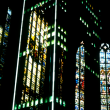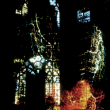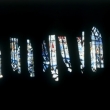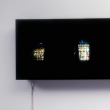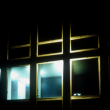“SIGNS OF FAITH” 1990
Entries from the Bruxelles Notebook
Living at the Sablon in monkish elegance: no phone, no television, no refrigerator. Only the radio, the ticking of a borrowed watch, and the competing bells from two churches.
◆
Investigated the church across the street, Eglise Notre Dame au Sablon. In churches, stained glass is meant to overwhelm the eye’s focusing mechanism, to dazzle the eye…indeed, to push the eye to the limits of dazzlement in order to initiate another level of “vision”: an early attempt to “blow the mind.” Stained glass is psychedelic iconography.
◆
The photographic transparency (whether a positive or a negative) may be thought of as the modern version of churchly stained glass. Apart from the simple shared fact of transparency, both are “holy” picturing systems; that is, as regards the claim to representing “truth,” both are picturing systems in which we “have faith.” What would result, then, were one to make and exhibit photo transparencies of stained glass? A partial answer is that doing so would push to the breaking point of literalism the camera’s unwavering faith in whatever image is presented to it. “The camera believes everything,” I always say. Let’s push this truth into overdrive and see what happens.
◆
As stained glass is to photo transparency, church is to lightbox.
◆
Downtown Bruxelles is filled with modernist office “lightboxes,” my favorite style of architecture. The exterior is simplified and we think more about the interior. These office buildings at night display row upon neatly ordered row of green glass rectangles which frame infinite variations on the theme of the neon-lit office interior…new “stained glass” monuments raised to honor the secular deities of commerce and bureaucracy.
◆
Church as lightbox from the inside during daylight hours/Office building as lightbox from exterior at night. Fusing the two photographically produces no-time and no-place (or rather, art-time, art-place) and, furthermore, parallels the condition of “belief” which is always, essentially, the radical confusion of exterior and interior states.
◆
The fusion of “sacred” and “rational” architectures provides a metaphor for the psychology of the art gallery, the site which accomodates the production of both “mystery” and “analysis.” Placing such fusions in a gallery, then, creates a kind of psychoanalytic stage set for the gallery. In effect, the gallery is caused to exhibit stills from a movie about its unconscious life.
◆
Stained glass and office buildings: break them down into constituent parts: color, light, architecture/lightbox, photography. Shuffle and recombine.
◆
The act of re-presenting images of stained glass via photography and lightbox isolates for our consideration the question of “faith” and “belief” in art. Are you a believer? If so, where do you locate your belief?: in the activity itself (whatever that may be); the social location of the artist; the result (“experiencing the object”); the result (meaning or effect)?
Reductio ad absurdum: any examination of faith reveals that what one has faith in is, finally, faith itself. Faith is the ultimate self-defining characteristic: whatever the object of our belief, whatever reasons we provide ourselves in order to maintain our belief in our enterprise, when it comes right down to it we simply and stubbornly believe in our belief. When our reasons burn away, or when we have long forgotten them, we resort to faith in our faith.
So too in art. We’ve not a shred of proof that art performs any of the functions with which we credit it. We simply believe “in it”–and fueled by that belief, art does perform. Art, then, is the medium for belief in art. Art houses our belief in art.
Question: what is produced when one “loses faith in art” but continues to make art anyway? Is it art that is made or something else?
⧫
On the strange fruit of photographically produced “impossible” stained glass (out of focus, double-exposed, etc.): What interests us, quite apart from the formal arrangement of a given picture, is a person’s decision to “extend” these representations of faith via the “technological naturalism” of photography and lightbox. The behavior interests us: stained-glass-as-lightbox seems to me to be comedy of the highest order…extremes of faith and skepticism made entirely congruent, one with the other. Such an enterprise is very likely sublime comedy.
Statement accompanying exhibition at Galerie Hufkens, Bruxelles, 1990


